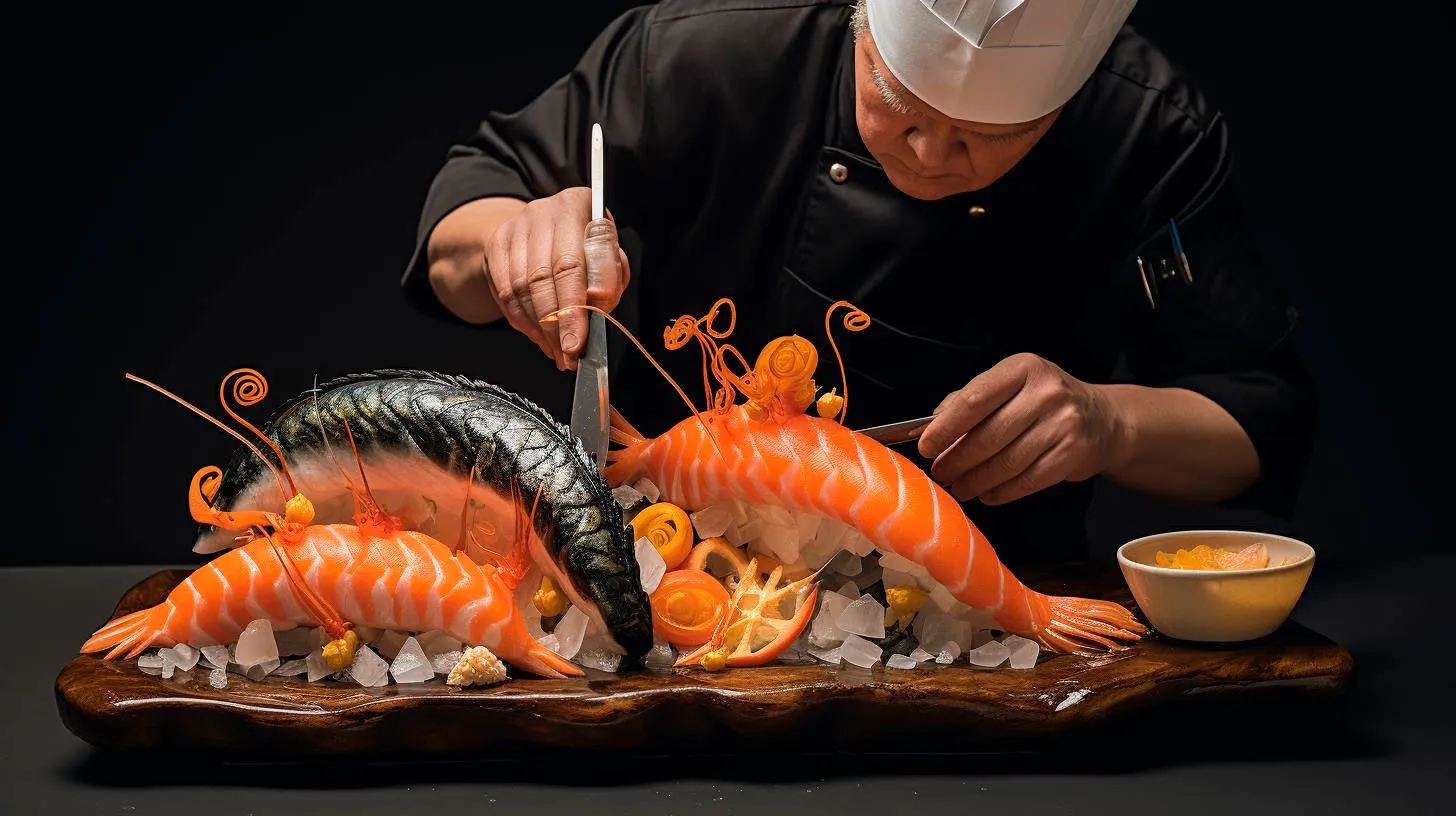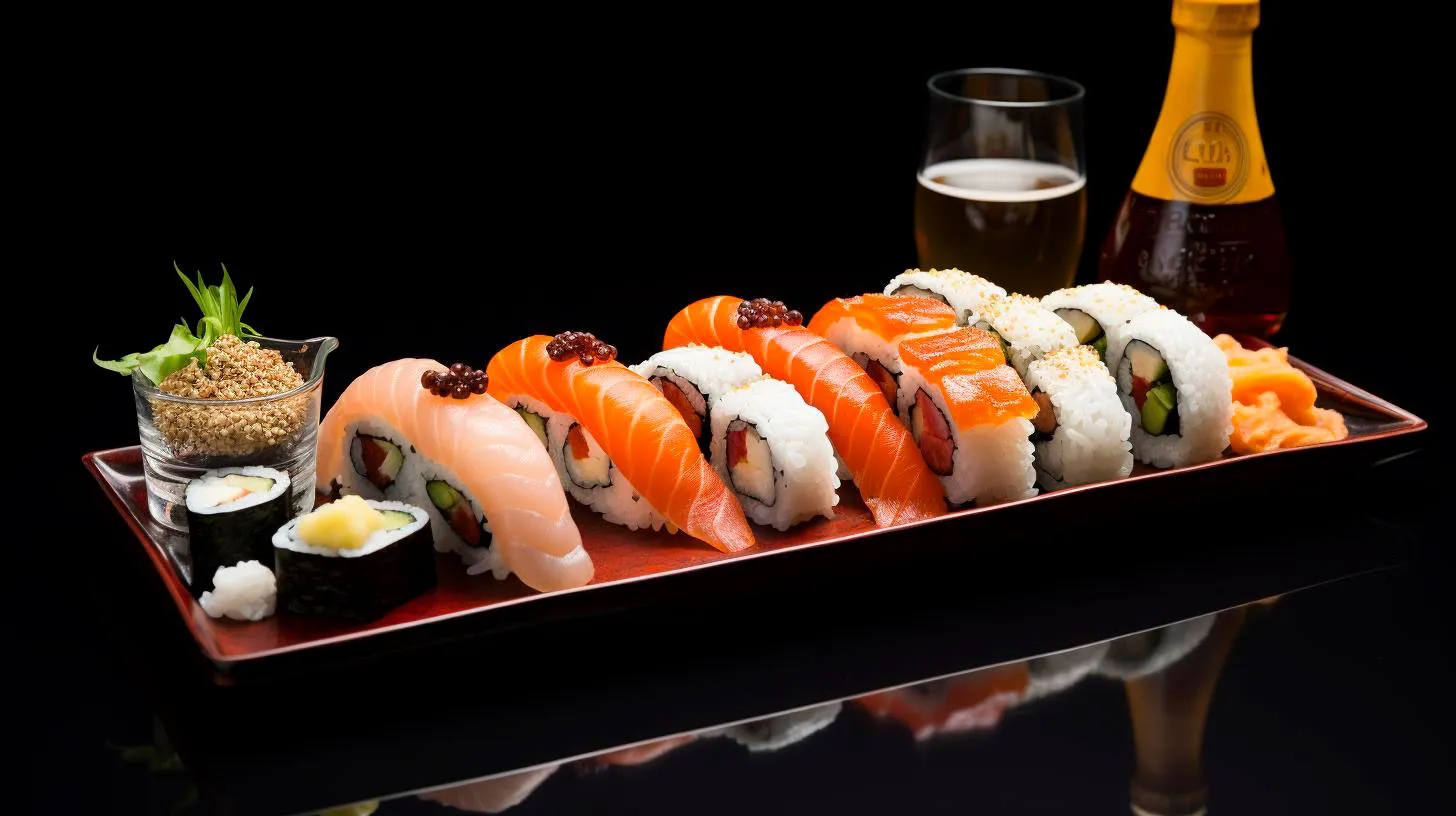Texture Matters: How to Achieve the Perfect Balance in Sushi Rolls
In this article, we will explore the importance of texture in sushi rolls and uncover the secrets to achieving the ideal balance.
The Importance of Texture in Sushi Rolls
Sushi enthusiasts know that each bite is an artful combination of flavors, textures, and visual appeal. Texture adds an extra dimension to the overall dining experience, creating a symphony of sensations that delight both the palate and the senses. Understanding and mastering the different textures can take your sushi game to the next level.
Softness as a Foundation
Softness is the foundation upon which a great sushi roll is built. Achieving the right level of softness ensures that the sushi is easier to bite and allows the flavors to meld harmoniously. Here are some techniques that sushi chefs employ to achieve the perfect softness:
- Using the freshest ingredients: Fresh fish and crisp vegetables contribute to a tender and succulent texture.
- Proper rice preparation: Cooking the rice to the right consistency and allowing it to cool properly creates a soft and sticky base.
- Expert cutting techniques: Carefully slicing the ingredients ensures a soft and consistent texture throughout the roll.
Chewiness for an Intense Experience
Adding a chewy texture to your sushi roll creates a delightful contrast that keeps the taste buds engaged. Here’s how you can introduce some pleasant chewiness:
- Using ingredients like cooked shrimp, squid, or octopus can add a chewy texture to your roll.
- Opting for thicker cuts of fish or vegetables provides a satisfying bite.
- Incorporating slightly undercooked rice can increase the chewiness of the roll.
Crunchy Elements for Excitement
A touch of crispiness can provide an exciting surprise as you bite into your sushi roll. The addition of crunchy elements not only enhances the texture but also adds a burst of flavor. Here’s how you can introduce crunchiness:
- Tempura batter: Lightly frying your vegetables or seafood in tempura batter gives them a satisfying crunch.
- Using crispy toppings like tempura flakes or deep-fried onions adds a layer of texture to your sushi roll.
The Secrets to Achieving the Perfect Balance
Now that we understand the significance of texture in sushi rolls, let’s dive into some secrets that will help you achieve the perfect balance:
- Experiment with ingredient combinations: Mixing different textures in your sushi roll will ensure each bite is unique and exciting.
- Don’t overload your roll: Too many ingredients can mask the subtle textures. Focus on a few key flavors and textures to let them shine.
- Pay attention to temperature: Serving your sushi rolls at the right temperature can enhance the texture experience. Cold ingredients provide a refreshing contrast to warm ingredients.
- Practice the art of rolling: Proper rolling techniques ensure that the ingredients are evenly distributed, resulting in a balanced texture throughout the roll.
Remember, achieving the perfect balance in sushi rolls is a continuous process of experimentation and refinement. Mastering texture will take your sushi creations to extraordinary heights, creating an unforgettable dining experience for yourself and your guests.
So, the next time you indulge in sushi, pay attention to the textures in each bite. Let the softness, chewiness, and crunchiness dance on your palate, and savor the symphony of flavors that only a perfectly balanced sushi roll can deliver!
The Art of Creating Crispy Sushi Rolls Techniques and Tips
In this article, we will explore the techniques and tips to create mouthwatering crispy sushi rolls.
Understanding the Crispy Element
Before diving into the techniques, it is important to understand how to achieve that perfect crispiness in sushi rolls. The crispy element in these rolls is primarily derived from the tempura batter or panko breadcrumbs used in the preparation. The batter or breadcrumbs are lightly fried, giving the rolls a satisfying crunch.
Technique 1: Tempura Batter
Using tempura batter is a popular technique to create crispy sushi rolls. The batter is made by mixing cold water with flour, cornstarch, baking powder, and sometimes egg. This mixture creates a light and airy batter that coats the sushi roll ingredients, resulting in a delicate and crispy texture when fried. Here are a few key points to keep in mind when using tempura batter:
- Ensure the batter is cold by chilling it in the refrigerator before using. This will help achieve a lighter texture.
- Do not overmix the batter to avoid developing gluten, which can lead to a denser texture.
- Use a deep fryer or a pot with sufficient oil to ensure even frying and crispy results.
Technique 2: Panko Breadcrumbs
Another way to achieve crispiness is by using panko breadcrumbs. Panko is a type of Japanese breadcrumb that is coarser and provides a crunchier texture compared to regular breadcrumbs. Here are a few tips to create crispy sushi rolls using panko breadcrumbs:
- Coat the sushi roll tightly with panko breadcrumbs, ensuring an even layer for consistent crispiness.
- For enhanced flavor, you can season the panko breadcrumbs with spices like garlic powder, paprika, or even sesame seeds.
- Fry the sushi roll in hot oil until the panko breadcrumbs turn golden brown for the perfect crunchy exterior.
Tips for Creating Crispy Sushi Rolls
In addition to the techniques mentioned above, here are some valuable tips to create crispy sushi rolls:
- Use fresh, high-quality ingredients to maintain the overall quality and taste of the rolls.
- Lightly steam vegetables like carrots or asparagus before rolling them to ensure they are tender but still hold their shape.
- Add contrasting textures by incorporating ingredients like cucumber, avocado, or crispy tempura flakes.
- Experiment with different fillings and sauces to create unique flavor combinations.
- Keep the sushi roll tightly wrapped using a bamboo mat to prevent any filling from falling out during frying.
By following these techniques and tips, you can elevate your sushi-making skills and create crispy sushi rolls that will leave your friends and family craving for more.
Key Takeaways
Crispy sushi rolls offer a delightful twist to the traditional sushi experience. Here are the key takeaways from this article:
- Crispiness in sushi rolls is achieved through techniques such as using tempura batter or panko breadcrumbs.
- Tempura batter should be cold, not overmixed, and fried evenly.
- Panko breadcrumbs should be tightly coated on the sushi roll and fried until golden brown.
- Using fresh ingredients and experimenting with fillings and sauces can enhance the overall taste and texture of crispy sushi rolls.
Now that you have learned the art of creating crispy sushi rolls, it’s time to put your newfound knowledge to use and impress your guests with your culinary skills!
Uncovering the Delicate Art of Making Soft Sushi Rolls
Today, we are going to delve into the delicate art of making soft sushi rolls and explore the techniques that can help you create your own mouthwatering masterpieces.
Why Soft Sushi Rolls Are a Must-Try
Soft sushi rolls, also known as uramaki, have gained popularity due to their intriguing texture and versatility. These rolls offer several advantages over their traditional counterparts:
- Enhanced flavor combinations: The soft sushi roll allows for a wider range of flavors and textures. You can experiment with different fillings, sauces, and seasonings to create unique combinations that cater to your taste preferences.
- Easier to eat: The rice on the outside of the roll makes it easier to handle and consume. The soft texture of the rice adds a comforting element to each bite.
- Attractive presentation: The colorful fillings peeking through the translucent rice give soft sushi rolls a visually appealing appearance. These rolls are often beautifully garnished, making them suitable for special occasions.
Mastering the Art of Soft Sushi Roll Making
Making soft sushi rolls requires precision and attention to detail, but with practice, anyone can create these delectable treats. Here are some key steps to help you master the art:
1. Choosing the Right Ingredients
The foundation of a scrumptious soft sushi roll is high-quality ingredients. Opt for fresh fish, crisp vegetables, and flavorful sauces. Some popular choices for fillings include avocado, crab, cucumber, salmon, and tuna. Your imagination is the limit when it comes to ingredient combinations.
2. Preparing the Rice
Rice plays a crucial role in soft sushi rolls. It should be properly cooked and seasoned. Japanese short-grain rice is the best choice due to its sticky texture. Once cooked, season the rice with rice vinegar mixed with a little sugar and salt.
3. Assembling the Roll
Place a sheet of plastic wrap on a bamboo sushi mat and cover it with a layer of rice. Flip it over, so the rice side is facing downwards. Add your desired fillings and carefully roll the sushi, using the mat as a guide. The plastic wrap will help you keep the roll tight and prevent sticking.
4. Cutting and Presentation
Use a sharp knife to cut the rolled sushi into bite-sized pieces. Wet the knife between cuts to ensure clean slices. Arrange the sushi rolls on a platter, garnish them with herbs or sesame seeds, and serve with soy sauce, wasabi, and pickled ginger.
Key Takeaways
Making soft sushi rolls is a skill that combines artistry with culinary expertise. To summarize our exploration:
- Soft sushi rolls offer enhanced flavor combinations, easier consumption, and attractive presentation.
- Choose fresh and high-quality ingredients for the best results.
- Properly cook and season the rice to achieve the ideal texture.
- Assemble the rolls carefully, using a bamboo sushi mat and plastic wrap.
- Cut the sushi rolls neatly and serve them with traditional condiments.
By following these steps and experimenting with different fillings and flavors, you can unlock a world of delicious soft sushi roll creations. So, gather your ingredients, muster your creativity, and embark on the extraordinary journey of making your very own soft sushi rolls!
The Sushi Texture Spectrum: Discovering New Dimensions of Roll Enjoyment
The Importance of Sushi Texture
Texture plays a vital role in the overall dining experience. Different sushi textures can provide a range of sensations, from the crisp crunch of vegetables to the tender melt-in-your-mouth feel of fish. By understanding and appreciating the sushi texture spectrum, you can elevate your enjoyment of this beloved Japanese cuisine.
The Sushi Texture Spectrum
Sushi offers a wide variety of textures, each providing a unique experience. Let’s dive into the sushi texture spectrum and explore the offerings:
1. Soft and Delicate
Sushi rolls with a soft and delicate texture create a gentle and refined experience. These rolls often feature ingredients like fresh fish or tender tofu, which provide a smooth and melt-in-your-mouth sensation. The soft texture is perfect for those who prefer a subtle and gentle sushi experience.
2. Creamy and Silky
Creamy and silky sushi textures are achieved through the use of ingredients like avocado or mayonnaise. These rolls offer a rich and indulgent mouthfeel, with a smooth and velvety texture. The creaminess adds a layer of luxury to the overall sushi experience.
3. Crisp and Crunchy
For those who crave texture contrast, sushi rolls with a crisp and crunchy texture are a delight. These rolls often include ingredients like tempura batter, cucumber, or radish. The satisfying crunch elevates the dining experience, providing a refreshing and invigorating sensation.
4. Chewy and Sticky
Chewy and sticky sushi textures, commonly found in rolls with ingredients like eel or octopus, offer a more substantial and satisfying bite. The chewiness provides a pleasant resistance as you bite into the roll, creating a unique texture that adds depth to each mouthful.
Key Takeaways
- Texture greatly enhances the overall sushi dining experience.
- The sushi texture spectrum includes soft and delicate, creamy and silky, crisp and crunchy, and chewy and sticky textures.
- Soft and delicate sushi provides a refined experience, while creamy and silky sushi offers a luxurious mouthfeel.
- Crisp and crunchy rolls provide a refreshing texture contrast, whereas chewy and sticky rolls offer a more substantial bite.
Discovering and appreciating the sushi texture spectrum is a journey that allows you to explore new dimensions of roll enjoyment. The next time you savor a sushi roll, pay attention to the texture and let it elevate your dining experience. Whether you prefer the soft and delicate, creamy and silky, crisp and crunchy, or chewy and sticky textures, there is a sushi roll out there to satisfy your cravings.



